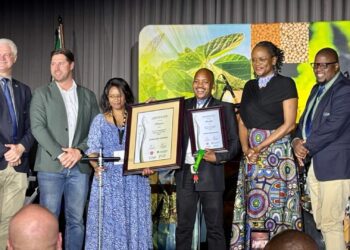Essential oils are proving to be much more than beauty products. At a recent scientific conference in Gauteng, researchers showcased the vital connection between indigenous crops and medicinal plants.
According to Bulelwa Ngcangatha, a production scientist from the department of agriculture in the Eastern Cape, with a master’s degree in chemistry, indigenous oil production holds great potential to boost the province’s economy. This is achieved by creating jobs in distillation, packaging, and branding, while also generating income and supporting the growth of new industries.
She explained that this initiative can also encourage sustainable farming through practices like intercropping and the promotion of indigenous and traditional food crops (ITFCs).

“By leveraging local expertise in conjunction with innovative technologies, this strategy aims to bolster food security, enhance biodiversity, and implement climate-resilient farming techniques, ultimately benefiting both local communities and the surrounding ecosystems,” Ngcangatha said.
Related stories
- Indigenous crops: The climate-smart superfoods we need
- Seeking healthier harvests: Experts turn to indigenous crops
- Indigenous flowers: A new path to profit for SA farmers
- SA agro-processors to hunt new markets in Germany
Ngcangatha explained that indigenous plant oils are rich in nutritional and medicinal properties, containing high levels of polyphenols, phytochemicals, and essential fatty acids.
Bulelwa Ngcangatha
“These compounds confer significant antioxidant, anti-inflammatory, and antimicrobial effects that can be comparable to or surpass those of more commonly used oils such as olive, canola, and sunflower.”
She noted that their unique composition shows promise for use in skincare, particularly for managing inflammation and offering sun protection.
They may also be developed as dietary supplements to support overall health and used in industrial applications such as natural perfumery and wood preservation.
Potential of climate-resilient indigenous plants
Indigenous plant oils hold significant potential to enhance food security and sovereignty among marginalised communities, says Sinazo Wutu, a scientific technician at Dohne Analytical Services in the Eastern Cape.
She explained that these plants provide highly nutritious and climate-resilient food sources, contributing to dietary diversity and local economies through sustainable value chains.
“The incorporation of these oils into food systems enhances nutritional security, uplifts household livelihoods, and preserves cultural heritage.”
However, their potential is limited by factors such as insufficient knowledge, negative cultural perceptions, limited access to seeds, and competition from subsidised commercial crops.

Some of the indigenous oils Wutu shared with Food For Mzansi include:
- Marula (Sclerocarya): The fruit yields an oil used in cosmetics for its moisturising and anti-ageing properties and as a nutrient-rich food ingredient. It thrives in Limpopo, Mpumalanga, and North West.
Marula oil is derived from the kernels, often using supercritical fluid extraction (SFE-CO2), which produces high-quality oil and a protein-rich byproduct. A key challenge is sustainable harvesting, as collecting fallen fruits can affect tree regeneration if seeds are not dispersed naturally. Opportunities lie in value-added products, bioactive compound research, and scaling up extraction to support local incomes. - Kalahari melon (Citrullus lanatus var. citroides): The seed oil is high in linoleic acid and γ-tocopherol, making it fast-absorbing and suitable for skincare and speciality foods. It grows in the Northern Cape, North West, and arid parts of the Western Cape. Seeds are washed, dried, and extracted either by decortication or pressing whole kernels.
Oils must be stored carefully to prevent oxidation. Wild harvesting offers economic opportunities for local communities. - African Immortelle / Impepho (Helichrysum odoratissimum): This essential oil is valued in natural cosmetics and aromatherapy for skin-healing and anti-inflammatory properties. Some chemotypes also repel insects. It is endemic to South Africa, found in parts of the Eastern Cape and Free State.
Oil is extracted by steam distillation of flowering tops, requiring prompt processing to maintain quality. Challenges include low yields and rapid biochemical degradation post-harvest.
Opportunities exist in sustainable cultivation, alternative extraction methods, and developing high-value medicinal, cosmetic, and insect-repellent products.
ALSO READ: Grain and oilseed markets: Tariffs shake up global trade


















